
The Moonville Tunnel

Vinton County, Ohio
If you’re in search of a creepy, haunted train-tunnel, you could hardly ask for a better one than this - or for a name more appropriate to such a mysterious location.
The Moonville Tunnel is weirdly photogenic - below, please enjoy my shots from a very chilly November morning, as I tell you about the history and lore associated with this site. For the record, although I visited here in the very month of a fatal 1880 train-accident attributed to the tunnel’s ghostlore, I did not experience anything out of the ordinary during this daylight venture.
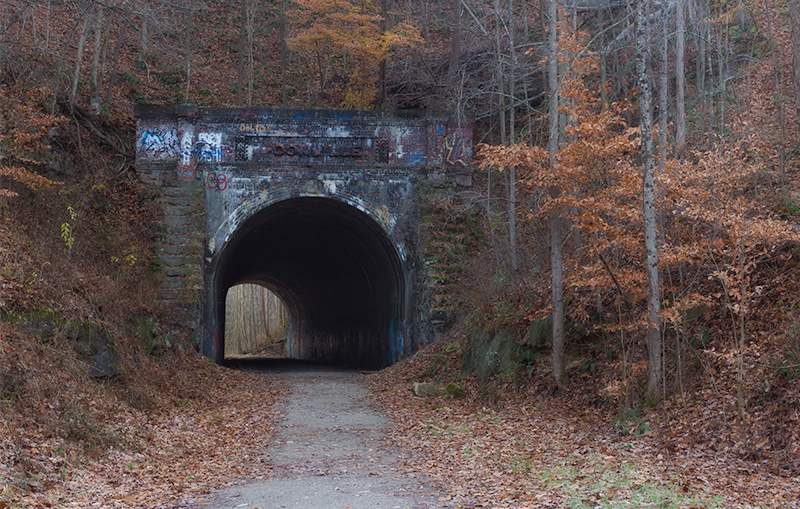
The Moonville Tunnel in Vinton County, Ohio, marks the site of a small, isolated town established here in the mid-1800’s. Although trains continued to run through this tunnel until the late 1980’s, Moonville itself became a ghost town after the 1940’s and little evidence of the community remains today. The tunnel and a small cemetery nearby are the most noteworthy reminders of human habitation in this wooded region of Ohio.
The Moonville Tunnel has a colorful history of train-related catastrophe and untimely demise, which has inspired a great deal of local folklore here. As at many other spooklight sites around the country, this location is said to be haunted by a lantern-wielding spirit who appears along the route of the former railway. Depending on which story you hear, the ghost himself may be seen as a phantom figure; otherwise, only his light is seen floating as if held aloft by an unseen hand (see Note #1).
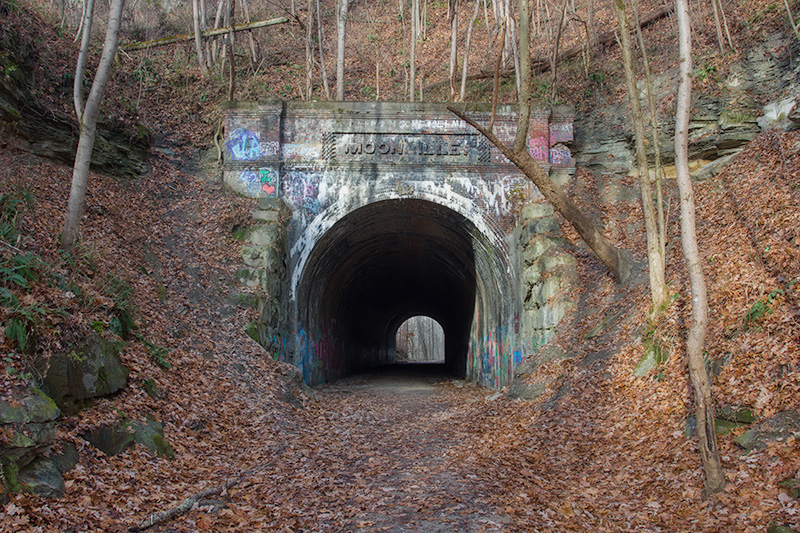
Today, the standard tale reads as follows:
“There was a railroad track that ran through the town,” said Ron Mills. “Each night a railroad man would stand along the tracks with his lantern to signal the train. One morning the man was found lying bloodless along the tracks. There were no clues to his death.” Since the mysterious death, Mills reports that on certain foggy nights passersby have seen a lantern eerily bobbing along the deserted railroad track.”
“Many Legends of Ghosts come from Ohio Hills”
The Circleville Herald - Circleville, Ohio - October 27th, 1978
Another newspaper tells the story with a bit less mystery surrounding the death:
“At the turn of the century, as the story goes, a brakeman was killed near the Moonville tunnel as he waved his lantern to stop the train. The man was exceedingly drunk and unfortunately swayed into the path of the oncoming steam locomotive. Reportedly, he was buried in the Moonville graveyard. And if you come here at night, some say you can see his lantern a-glimmerin’ and a-wavin’, still trying to stop the train.”
Lancaster Eagle-Gazette - Lancaster, Ohio - Thursday, February 19th, 1987
(quoting a Zaleski Backpack Trail publication).
A similar account from the Marion Star differs from other tellings of the tale only in regard to the location of the ghostly lanterns sightings, preferring to report them from the nearby Moonville Cemetery, rather than along the tracks themselves:
“During its boom days, the train would run through town three or four times a day to pick up and drop off supplies. One night the brakeman had been drinking too much. As he was standing near the Moonville Tunnel, waving his lantern to stop the train, he fell in the path of the train and was killed. He was buried in Moonville Cemetery. At midnight when there is a full moon, people can see his lantern in the graveyard, still trying to stop the train.”
“Stories Keep Ghosts Alive in Ohio’s Parks” - by Jan Fields
The Marion Star - Marion, Ohio - Friday, October 23rd, 1987
The tales quoted above appear to be garbled accounts of an actual incident which took place in 1859; in that year, a train brakeman, accused of intoxication, fatally fell from his perch on the train. He did NOT sway into the tracks while walking near them with a lantern, since that’s not where a train brakeman would actually be - nor would he be using a lantern to signal the train, either. Those details are pure folklore. In any case, this accident appears to be the earliest reported death along this line:
"A brakesman on the Marietta & Cincinnati Railroad fell from the cars near Cincinnati Furnace, on last Tuesday March 29, 1859 and was fatally injured, when the wheels passing over and grinding to a shapeless mass the greater part of one of his legs. He was taken on the train to Hamden and Doctors Wolf and Rannells sent for to perform amputation, but the prostration of the vital energies was too great to attempt it. The man is probably dead ere this. The accident resulted from a too free use of liquor."
The McArthur Democrat - McArthur, Ohio - March 31st, 1859
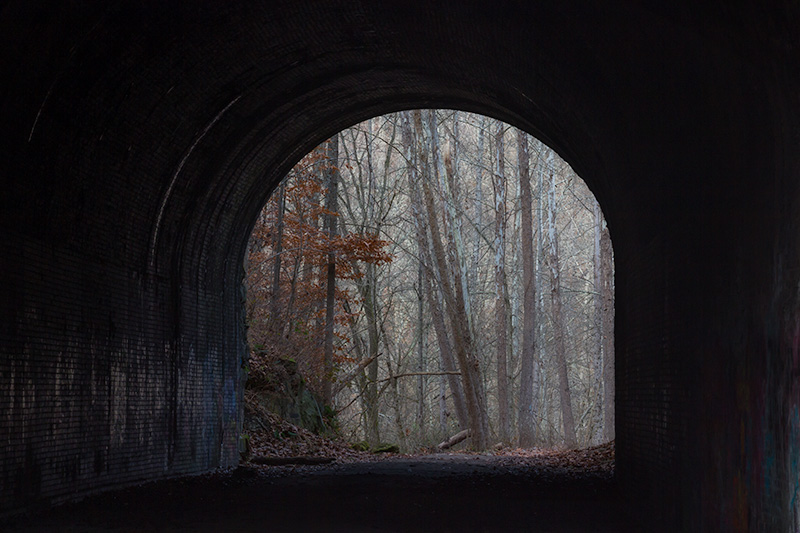
There were numerous other fatal accidents in the vicinity of the tunnel; so many people have met their end at this location that it’s difficult to determine which death is most credibly attributed to the ghost story. From time to time, pedestrians were struck and killed while walking along the tracks, or even while sleeping on them in one notable case. These accidents sometimes occurred while people were walking through the long tunnel, or while attempting to cross a nearby trestle bridge. Drunkenness is often cited as a factor in these incidents.
http://www.hauntedhocking.com/Moonville_Tunnel_Brakeman.htm
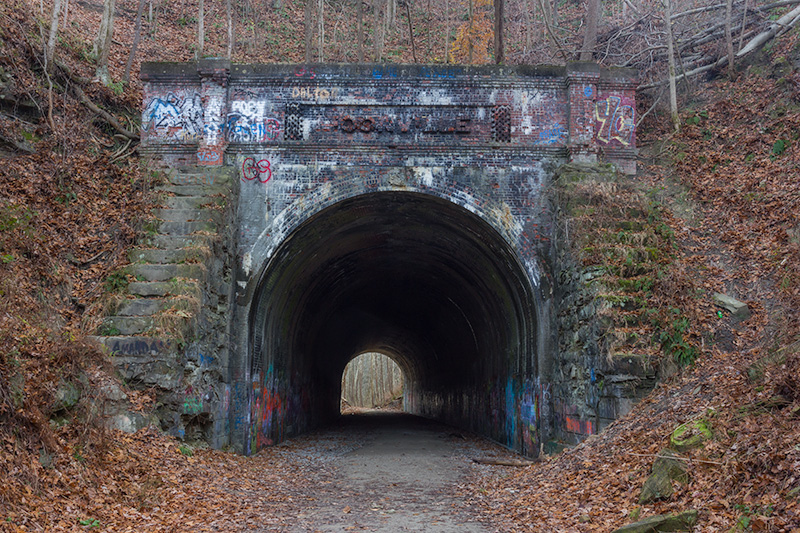
Of all the fatal accidents here, the tragedy most strongly associated with Moonville’s ghost-lore is a train collision reported to have occurred in 1880. In that instance, two trains collided while traveling in opposite directions on the same track. The accident is said to have resulted in the death of the engineer, Frank Lawhead, as well as the death of a fireman and the injury of six others:
“Cincinnati, Ohio, Nov. 5. - Two freight trains ran together on the Marietta and Cincinnati Railroad, near Moonville, on the eastern end of the road, yesterday. Engineer Frank Lawhead and Fireman Charles Krick were killed and six of the crew wounded, none fatally. The cause of the collision is said to have been the failure of the train dispatcher to notify the east-bound train of an order to the west-bound train to run on its time.”
Chicago Tribune - Saturday, November 6th, 1880
Oddly, this event does not seem to have been reported in Ohio newspapers at the time, although it was widely reported in newspapers in several other states. The text above is from the Chicago Tribune of Saturday, November 6th, 1880:
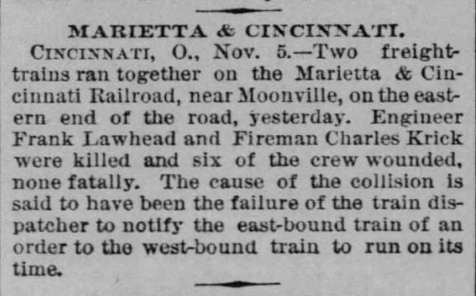
Papers in other states printed exactly the same text in almost every case.
Whether or not this disaster ever really occurred is questionable; the apparent failure of Ohio papers to run the story in 1880 gives me cause to doubt the story’s veracity (see Note #2).
Nevertheless, one Ohio paper, the Chillicothe Daily Gazette, mentioned the train collision many years later, in connection with a ghost story that had become well-established by then. A sighting of the ghost was actually published as a credible report on Wednesday, January 23rd, 1895 (see Note #3). The paper offered the following remarkable account:
“The Ghost of Moonville, after an absence of one year, has returned and is again at its old pranks, haunting B. & O. S.-W. freight trains and their crews. Monday night the ghost appeared just east of the cut, which is one half mile the other side of Moonville. It showed up in front of fast freight No. 99 westbound, which is due at Moonville at 8:50 p.m. The train was hauled by engine 226, in charge of Engineer William Washburn. The conductor was Mr. Charles Bazler. The ghost was attired in a pure white robe, and carried a lantern. It had a flowing white beard, its eyes glistened like balls of fire, and surrounding it was a halo of twinkling stars. As the train approached, the lantern was swung across the track. Engineer Washburn gave the proper whistle signal, and stopped the train. As he did so, his ghostship stepped of the track and disappeared amidst the rocks nearby.”
Obviously, this report refers to a story already familiar to train conductors by that time. The article continues by making reference to the 1880 collision:
“This is not the first time the same ghost has stopped and delayed trains. It has been at that business, off and on, since the frightful collision at that point, in which Engineer Lawhead lost his life and Engineer Wash Walters was injured.”
At first, I was skeptical that such an article would ever have really appeared in a newspaper, even in 1895. But, here it is, as I found it in an online archive:
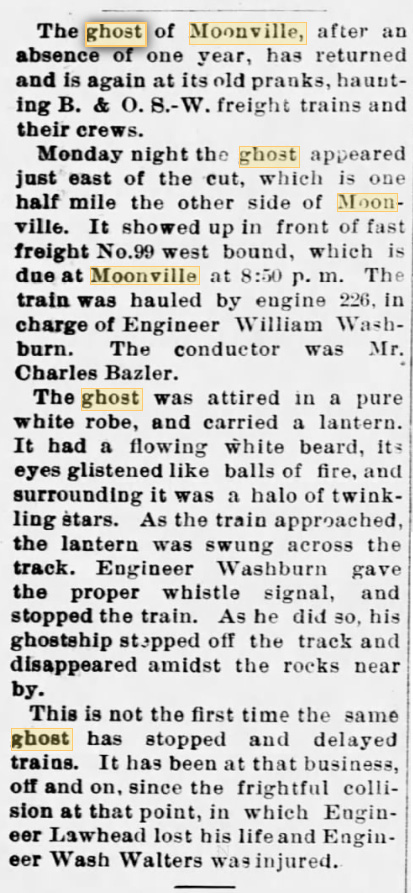
This story was apparently well-known throughout the region. Rival train lines were apparently envious of the attention that the story attracted; note this comment in the same paper:
“The N. & W. men say they will have to scare up a ghost somewhere; that it won’t do to let the B & O. S. W. have all the glory along that line.”
Chillicothe Daily Gazette, page 4, Tuesday, January 29th, 1895
This is not to say that there was ever any validity to the tale, of course. As other articles in the Chillicothe Gazette reveal, impersonating a ghost was a popular form of entertainment at that time. Note the following article about a story from a community not far from Moonville:
“Miss Edith Hurst, of East Fourth Street, entertained the Terpischorean Club, at her home last night, with a “ghost story” party… Miss Mary Hurst had a fund of stories prepared for the occasion, and the lights being turned down, she told one in which the ghost was to appear. At this juncture, someone happened to go in the yard, and there stood the ghost, a tall, white figure, with ghastly lights and flashes appearing on its outstretched hands.
“The whole party then went out to see the ghost, which was represented by Mr. Will Erdman. Mr. Erdman had a clever arrangement, by which the flashes in his hands were produced. A small tube ran up to the juncture of the arm and body, and this was half filled with magnesia. By lowering his arms, a small bellows was pressed, and this blew the magnesia through the tube onto some alcohol lamps, which he had in his hands, and this made the flashes.
“All was moving along nicely, and the specter appeared quite unearthly, until some of the alcohol and magnesia got on his hands and burned them. The ghost immediately became very earthy and commonplace, for with an exclamation something like the one which is heard when a man steps on a tack, he put out the lights and tore the sheet from his body.”
Chillicothe Daily Gazette, Saturday, August 3rd, 1895
The “ghastly lights and flashes” described here sound remarkably similar to the “halo of twinkling stars” that were said to surround the Moonville ghost, and I have to wonder if that’s more than a coincidence.
It seems that the exchange of ghost stories was a hugely popular pastime along the railroad line, as one reporter complained in the Chillicothe Gazette:
“B. & O. S. W. trainmen have, almost in general, a penchant for telling ghost stories. Nearly every morning, the railroad reporter hears of some new night prowler from the other world, which the men see while on their runs. Of course, they don’t see them, but they make a good story to tell the gullible looking reporter.” (See note #4 for a more detailed account)
Chillicothe Daily Gazette, Thursday, October 17th, 1895:
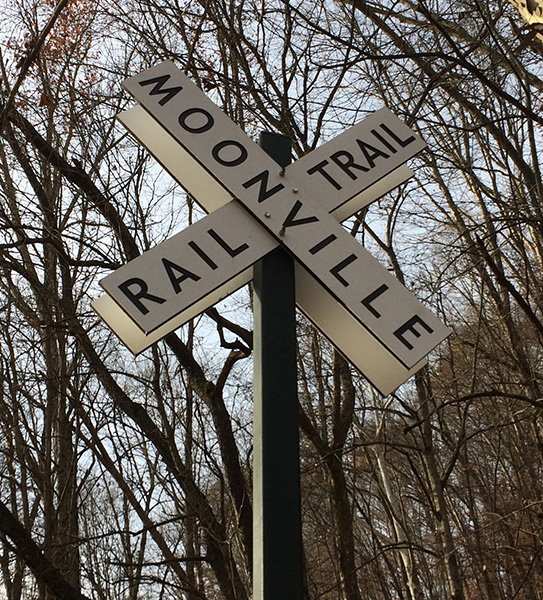
You can also access it by car via a gravel road. Near the town of Zaleski, take route 278, then turn onto Shea Road, just across from Lake Hope. On maps, Shea Road magically transforms into Route 18, the Hope/Moonville Road, but you won't notice that while driving. The road follows Raccon Creek for a few miles before you arrive at a small dirt parking area near the tunnel.
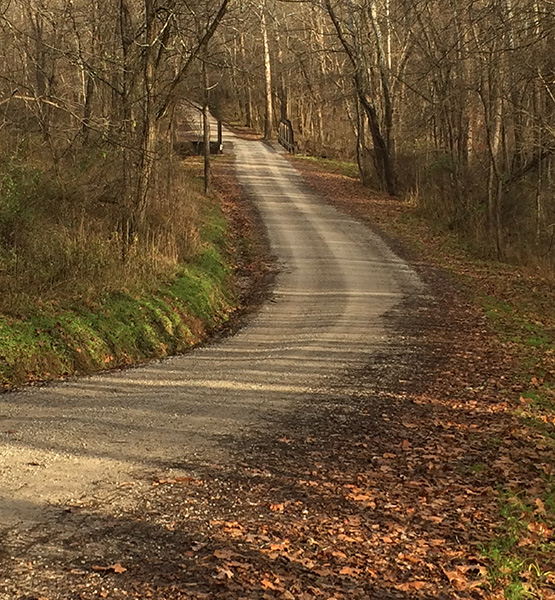
Once parked, you'll have to cross this ugly bridge on foot to reach the tunnel:
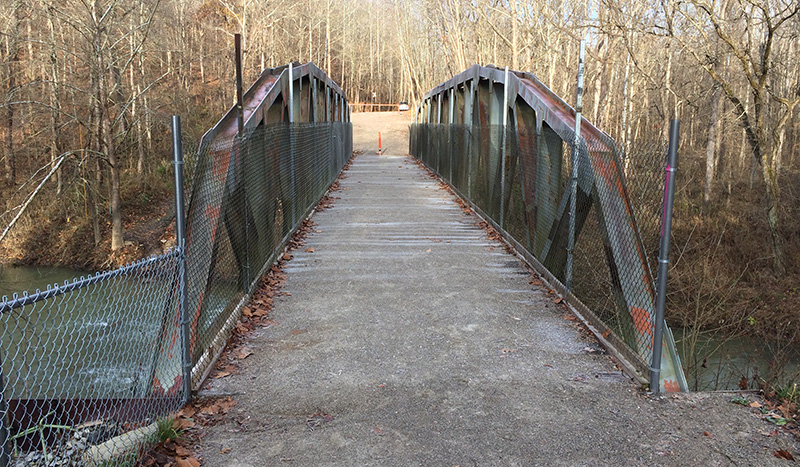
Locals leave colorful messages to welcome you on the bridge. For the record, I did cross the bridge, but did not die:
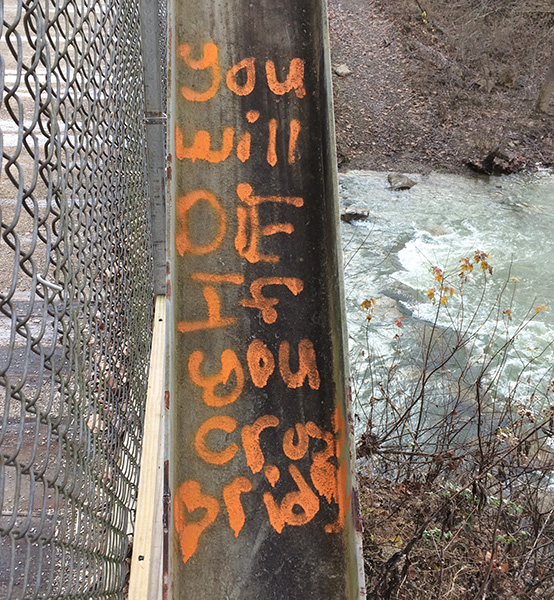
The tunnel itself is likewise adorned with graffiti:
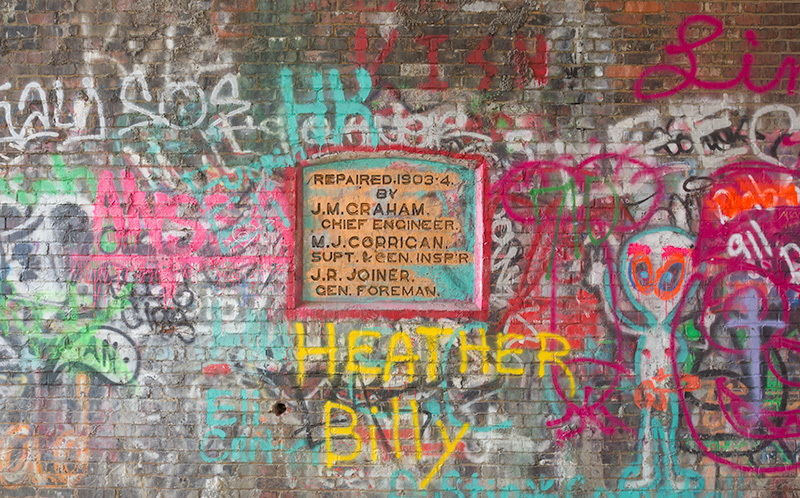
Notes
Note #1 -
A typical story from the modern era is said to have been reported in the Athens Messenger - I have not been able to independently locate this article online, however, so the accuracy of the following account of the article is unverified:
“A 1993 Athens Messenger story told the story of David, an OU student who went to Moonville to swim in Raccoon Creek. On their way back through the tunnel they saw a light halfway down it, and split into two groups, since they had beer and two of the four of them were underage. The other two headed for the light, then came running back out of the tunnel, screaming, "There's no one carrying the light!" David went to check it out for himself. "He wasn't kidding," he reported. "It was just a swinging light with no one holding it. I hightailed it back to the car. I haven't been out there since."
http://www.forgottenoh.com/moonville.html
Note #2 -
The 1880 accounts may be later retellings of an accident that had apparently occurred in Moonville years earlier, in 1874, as reported very briefly in a local paper at that time:
“There was a smash-up of two freight trains at Moonville, on Tuesday, by which eleven cars were wrecked and a fireman killed, whose name we did not learn.”
The Vinton Record - McArther, Ohio - Thursday, July 16th, 1874
Here we learn of a deceased fireman, who remains anonymous, while other accounts tell us that an engineer and a fireman died, or that the deceased were two engineers, etc.It’s all a bit confusing and pretty difficult to verify.
Note #3 -
Online sources often cite the date of this article as Sunday, February 17, 1895 - but there is no such edition, because the Chillicothe Gazette did not print on Sunday. You’ll actually find the story printed on the fourth page of the Wednesday, January 23rd issue of that year. Since the story cites Monday as the day of the ghost’s appearance, that would make January 21st, 1895 the date of this haunting. To complicate matters further, page 4 of that edition misprints its own year as “1894,” although that appears to be merely a typo - all of the edition’s other pages say 1895. A fine example of how difficult it can be to track down old stories like this.
Note #4 - the full text of the article quoted:
“B. & O. S. W. trainmen have, almost in general, a penchant for telling ghost stories. Nearly every morning, the railroad reporter hears of some new night prowler from the other world, which the men see while on their runs. Of course, they don’t see them, but they make a good story to tell the gullible looking reporter. The Marietta Register, however, has found a case where an engineer and fireman really did think they saw a ghost, and the two men will probably not hear the last of it for some time.
“When they arrived the West Side depot at three o’clock in the morning, they saw a long white figure standing near the station. Neither one cared to go see what it was, so when they reached the Union depot, they found a policeman and hurriedly sent him to hunt the ghost. The officer merely found a cook from one of the bakeries nearby, in his white suit, and the engineer and fireman haven’t been heard to say a word about ghosts since.”
Chillicothe Daily Gazette, Thursday, October 17th, 1895:
The large number of ghost stories going around may often have been the result of merry pranks such as the one described below, although jokes of this nature didn’t always end well:
“They Played Ghost - Massillon, O., Sept 9. - William Conrad and Frank Webb unwisely undertook to impersonate a ghost that has been exciting the superstitious for several weeks with disastrous results. Conrad mounted Webb’s shoulders and the two were draped in black. They encountered a searching party, and refusing to halt, Henry Ryder opened fire with his revolver, and the ball lodged in Webb’s body, and thereupon he made himself known with alacrity. His wound is painful, but not necessarily fatal.”
Chillicothe Daily Gazette, Monday, September 9th, 1895
And this one:
“There was a report, yesterday, in the west end, that a ghost had been seen on Fourth Street, and that it had nearly frightened the Welch brothers, Charley and Mike, into their coffins.
“It was a clever story of spirit life and many people believed it. Even the Daily News put the stamp of approval upon it, and published it as the truth, the whole truth and nothing but the truth. The reporters of this paper did not stop at a nibble, but swallowed the hook, line and all.
“Investigation on the part of The Daily Gazette shows that the ghost was a manufactured one. Two gentlemen, Messrs. Dennis Sullivan and Jack Moriarity, and a white sheet, were in the play. They played their parts well and accomplished what they intended to accomplish, viz: scared the Welch boys into a hasty retreat, the strides of which were marked by their heart beats.”
Chillicothe Daily Gazette, Saturday, February 2nd, 1895:
Back to the Spooklights main page
or return to The Sleepy Hollow Compendium